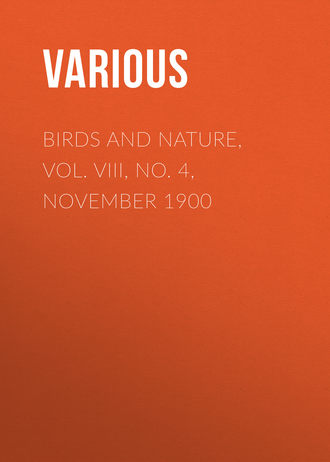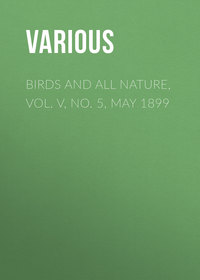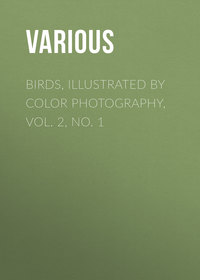 полная версия
полная версияПолная версия
Birds and Nature, Vol. VIII, No. 4, November 1900
Once this summer a blunderer smarter'n common came along by us. We had a nice place, too, in a dreadful blackberry tangle. A small sassafras threw a nice shadow over it when the sun got hot. Well, I shut up quick, I tell you. Was just tellin' Mrs. Chat a few things while she kep' an eye on our four eggs like. We kep' still as mice. But didn't that blunderin' rags march right up to our door and push and scratch till she saw what we had? Had a little rag blunderer with her. An' she held her up to look in, too. Every single feather we had stood on end! It was good riddance when they went along. Couldn't believe my specs when I saw they had left our eggs alone. Seven suns after, big rags came back. We're in a peck o' trouble. Our four bairns just out the shell. We both had to scratch round with all our toes to feed and keep 'em breathin'. Been rainin' for a solid week. Dame Chat said she just knew they'd get a chill and die. But the blunderin' party didn't stay long.
Well, sir, we hadn't got rid of that blunderer yet. The nex' time she brought another, bigger one, along. Both crowded up and looked in our door. You never saw such beauties as our bairns that day. Just gettin' so plump and featherin' right along. But it meant a sight o' work for us. They just sat and took in every mouthful we could rake and scrape. They kep' us busy. Well, when these blunderin' rags shook the house the bairns all up and spread their jaws wide open. Rags thought it was awful cute, but I'm thankful they didn't offer to feed 'em anything. Did bad enough, anyhow. Big one said, "Why don't you take their picture?" First rags said she couldn't. Second rags said she'd try, anyhow. With that, first rags began to snap off our best defenses – without so much as by your leave. They scratched her good, anyhow; for she said so. Well, she put some kind of square black gun right up to our door. Dame Chat went into hysterics and those little Chats just boiled over like a teakettle and went out the nest in four different directions! The two blunderers went off in a hurry, both talkin' at once and one suckin' her paw. Thankful to say ain't ever seen 'em since. But Dame Chat's a nervous wreck from the fright they gave her; and I'm worked to skin and bone takin' care of the little Chats. I just wish all the town's fenced in so's blunderers couldn't get loose to meddle round in their bunglin', elephant, rhinoceros way!
Elizabeth Nunemacher.He comes – he comes – the Frost Spirit comes! You may trace his footsteps nowOn the naked woods and the blasted fields, and the brown hill's withered brow.He has smitten the leaves of the gray old trees where their pleasant green came forth,And the winds, which follow wherever he goes, have shaken them down to earth.– John Greenleaf Whittier.THE LUNA AND POLYPHEMUS MOTHS
The two silk-worm moths which we figure this month both possess a point of excellence far in advance of any other of our native silk-worm moths; Luna on account of its graceful form and delicate colors, and Polyphemus for the silk of its cocoons.
It seems that most persons who speak of the Luna moth (Tropaea luna) feel called upon to give a more or less poetic description of it. This, I hope, has been rendered unnecessary by the colored plate, so that it will suffice simply to mention that the beautiful shade of green is of very rare occurrence among our larger moths, and that no other has the long, graceful "tails" on the hind wings, a characteristic which adds greatly to the beauty of this insect.
This moth does not seem to be very abundant anywhere, but when once seen will long be remembered on account of its great beauty. The green and yellow colors are evidently very closely related, because either one may, to a greater or less degree, replace the other, so that some of the moths have quite a strong, yellowish tinge. One of our common swallow-tail butterflies (Iphiclides ajax) possesses a very similar green color in its wings, but does not seem to show this tendency to replace the green by yellow. On the wings are four eyespots which are also found in Polyphemus. These are remarkable in that they are transparent in the center. This clear area in Luna is quite small, while in Polyphemus it is about as large as the entire eye spot of Luna. The legs are brown and colored like the front edge of the fore wings. The hairs on the body and at the base of the wing are very long and are white or yellow. The wing expanse ranges from three and three-fourths to five and one-half inches.
During April or May the mother moth lays her dark-brown or chocolate-colored eggs upon hickory, walnut, beech, oak, and a few others of our forest trees. The limited number of food plants is doubtless one reason for the rarity of the moths, as compared with such a common and almost omnivorous larva as Cecropia. A single moth may lay about one hundred eggs, which are smaller than those of Polyphemus. These hatch in about ten or fifteen days, the larva making its escape by eating a circular hole in the shell. Occasionally a young larva may be seen crawling about for a short time, carrying upon its head or tail the empty shell.
The adult larva is about three inches long, of a delicate pale green, a color very difficult to preserve in the dead larva. Those on the plate have lost this delicate green and have become yellow, but show the form perfectly. This larva is very much like that of Polyphemus, but may be distinguished from it by possessing a longitudinal pale yellow lateral line, which is not found in Polyphemus. Since the cocoon is quite thin and contains but little silk, it is considered of but little value. This cocoon is spun among two or three weaves, and is about two inches long. Some authors claim that the cocoon falls to the ground with the autumnal falling of the leaves; others that it transforms on the ground among the fallen leaves. The cocoon is quite similar to that of Polyphemus, but not so firmly attached when fixed to a stem. The moths emerge in April and May, there being only a single brood in the north, while there are two in the south.
The color of the cocoon seems to be influenced in some way by the kind of food eaten by the larva. Cocoons made by larva which have been fed on hickory leaves have a darker color. In the true silk worm moth this same influence has been noticed; larvae fed upon the vine producing red cocoons, on lettuce emerald green cocoons, while those fed upon white nettle produce yellow, green or violet cocoons. It is necessary in order to procure these results, that the larvae be fed upon the mulberry till about twenty days before the formation of the cocoon.
Polyphemus. The life history of this native silk worm (Telea polyphemus) is by far the best known, because many years ago it was very carefully studied with the hope that it would prove an important silk insect. This hope unfortunately has not been realized.
The moths, as shown by the plate, are really beautiful; the large eye spots on the hind wings contributing much towards this effect. The transparent, window-like centers in the eye spot are also of quite rare occurrence among our moths. These transparent areas do not possess the very minute scales found on the other parts of the wing. Almost all of the wonderful variety of colors found in the wings of butterflies and moths are due either to coloring matter in these scales, or to the breaking up of the white light by minute lines on these scales, such as are seen in the play of colors on a soap-bubble. These fine lines on the scales are only on the upper side, and are about one-sixteen-thousandth of an inch apart.
The eggs of Polyphemus are very much flattened, about the size of those of Cecropia, and are deposited on leaves and twigs singly or in small groups. These hatch in about ten days and usually in the morning. The young larva often devours the shell which a few moments before afforded it shelter. This larva feeds upon oak, hickory, apple, maple, elm and a variety of other trees, and thus has a larger range of food plants than the Luna larva. The rate of growth is prodigious, as has been shown by Mr. Trovelot. When the larva hatches it weighs about one-twentieth of a grain; in ten days it weighs one-half of a grain, or ten times its original weight; in twenty days it weighs three grains, or sixty times its original weight; when a month old it weighs thirty-one grains, or six hundred and twenty times its original weight, and has consumed about ninety grains of food; after fifty days it weighs two hundred and seven grains, or over four thousand times the original weight. At fifty-six days the larva has eaten eighty-six thousand times its original weight in food! It is therefore not surprising that these larvae can often be easily detected upon trees by the large number of leaves which they have devoured.
To provide for this great change in size, the larva moults five times, but the time between these moults is not always the same; there is usually about ten days between the first four moults and about twenty between the fourth and fifth. The larva stops eating a day before the moult, spins a few threads upon the leaf to which it attaches its hind legs, and waits for the transformation, which usually takes place in the afternoon. The larva, when mature and ready to spin its cocoon, is about three inches long. It is sometimes influenced in its color by the food plant; the normal larva being of a golden green, although it has been known to show more yellow coloring when found on red maple.
A short time before beginning its cocoon the larva ceases to eat and selects a place for its cocoon. These cocoons are usually found upon the ground among the leaves, but are frequently attached to twigs. After about a half day's work the larva spreads over the inside of the cocoon a gummy, resinous substance, which binds together the threads. After four or five days more of almost continuous work, another coating is smeared over the inside, which renders the cocoon practically air-tight. The silk fibres become considerably finer as the cocoon nears completion and the supply of silk begins to run low. For this reason the inner layers of the cocoon are only about half as strong as the outer ones. The larva, as the supply of silk diminishes in the silk glands, becomes perceptibly reduced in size. It has been estimated that the larva, in attaching the continuous thread of its cocoon, makes two hundred and fifty-four thousand back and forward movements. The cocoons are very strong and dense, of a dirty white color and generally coated with a white powder, the female being the larger.
There is but a single brood in the north, while in the south there are two.
In order to see if the pupa needed air, Mr. Trovelot sealed up some cocoons over winter in shellac, but the moths emerged in due time after being in an air-tight space for nine months. He also delayed the emergence of the moth till twenty-one months after entering the cocoon by placing it upon ice.
The silk in the spinning glands before it is spun is a clear, transparent fluid. These glands seem to be of excessive size when compared with that of the larva, since, when fully expanded, they reach the great length of twenty-five inches, or about eight times the length of the full-grown larva. These glands are paired, one being found on each side of the body, are considerably folded and taper at each end. The ducts leading from the anterior end of the glands unite to form a single duct which opens below the mouth. The thread is double, being really composed of two different fibres, one from each gland, as may be shown by separating them. The silk in these glands is prepared and sold as silk "gut" to anglers. On account of its transparency when in water, it becomes invisible and thus aids in deluding the wary fish, who does not see any connection between the line and the baited hook. The "gut" is prepared as follows: Larvae which are ready to spin their cocoons are cut open and placed in strong vinegar for eighteen hours; the glands are then taken out, stretched and dried in the shade.
Six or eight days after beginning the cocoon, the larval skin is moulted and the real chrysalic or pupal stage begins. This stage normally lasts till the following spring or summer. A few days before the time of emergence a pair of glands which open into the mouth become very active and secrete an acidulated fluid which escapes and wets the fore end of the cocoon, causing the resinous material binding together the fibres to become soft. Even cocoons sealed up in shellac and starch have been dissolved by this fluid, and thus the moths have been able to escape. When the cocoon has become sufficiently soft, the moth pushes its way between the fibres, but in doing so often breaks some of the threads, thus making the silk of such cocoons useless for commercial purposes. The moth at the time of emergence, with its folded and crumpled wings, is quite a forlorn-looking object. These wilted wings soon begin to fill up with fluids from the body, which is very large at this time. In some cases, the fluid is driven into the wings with so much force that they swell up, and if such a wing is punctured, thus allowing some of the fluid to escape, the mature wing will be of a smaller size than one from which no fluid has been lost. It must be remembered that it is possible to inflate a butterfly or moth's wing, because the wings of insects are not composed of a single layer, but are sacs of two layers which are closely applied. It is thus possible to split the wing into upper and lower halves, but this can only be done at the time of emergence, when these two layers are not so firmly cemented together as they are in a few hours after emergence.
The enemies of Polyphemus are numerous. Birds prey upon the larvae, in addition to numerous parasitic insects which are very similar to those which destroy Cecropia. The cocoon itself is not a complete protection because rats and squirrels plunder them. We thus see that the life of even an insect is full of dangers, and that it is really a wonder that so many are able to become mature and reproduce.
The silk-worm moths are excellent illustrations of what is called complete metamorphosis in insects. An insect like the grasshopper, when it hatches from the egg, is very much like the adult insect in its general form and appearance; the most evident difference being the lack of wings. An insect which shows such slight changes in its growth to maturity is said to have an incomplete metamorphosis. It is incomplete in the sense that the change is not of a very radical nature. But in the case of the silk worm moths, and moths and butterflies in general, the larva which hatches from the eggs has not even the most superficial resemblance to the adult insect, the fully-developed moth. This necessitates a complete change or metamorphosis in the form and structure of the insect before it can become mature. This great change is accomplished during the quiet pupal stage in the cocoon. Because the pupa is apparently passive when viewed from the exterior, one must not conclude that it is so internally; far from it; the digestive organs of the larva must be completely made over from those of a chewing leaf eater to those of a moth which can only take liquid food.
Charles Christopher Adams.CASTLES IN THE AIR
In a little bend of the San Joaquin River, where the current, attempting to straighten its course, has left a bank a few feet wide, there is a small grove of tall cottonwood trees, perhaps a dozen in number, whose branches lean far over the stream and whose tops reach almost to the level of the bluff or rather the floor of the valley 250 feet above, for this swift river has, in the course of ages, cut thus deep a channel for itself.
The place is not easy of access, for the shore narrows above and below the bend to a few inches where one with difficulty keeps from crumbling away the sand with his feet and falling into the water, and the cliff is so nearly perpendicular that in many places it is inaccessible to a climber, being of soft sand whose different stratas are clearly defined where they have been sliced off by the cutting stream.
The valley above is a vast grainfield out almost to the edge of the bluff, and along the edge and face of the bluff, wherever root can cling or tendril hold, grow beautiful wild flowers in the early spring days – their last refuge between the cultivation and the deep sea, or rather, river.
In the tops of the cottonwoods live a number of baronial families in castles huge, gray and ugly, overlooking the sweep of the stream. They are the Great Blue Herons whose Latin title, (Ardea herodias), gives one some idea of their ancient lineage. They claim to be older than the storks of Egypt, and indeed, they look older as they stand humpbacked and sleepy on one leg by the side of their nests, the long fringe of light-speckled neck feathers underneath looking like a long gray beard sweeping over their recurved neck and breast. There is a wise look about them, too, for the black markings of the head sweep back over the eye and prolong into the appearance of a quill extending behind their ears.
Though they are almost four feet long and spread their wings to six feet and over, the herons' large blue-grey bodies are often almost indistinguishable from the bark of the cottonwood branches and the blue of the sky against which they are silhouetted so oddly. One's eyes open with astonishment when these sticks or excrescences of the tree-tops slowly unfold an enormous sweep of sail and, extending their long stilts behind them, flap off across the stream with a creaking sound like the pulleys of a vessel when the halliards are running through them. Standing or flapping they are not handsome birds and one who comes suddenly upon a large heron for the first time as he stands in the shallow water of the brookside, will be convulsed with laughter, for if there is an utterly clumsy and awkward form or motion in bird-life it belongs to this heron.
Their homes are big baskets of nests made of twigs as large as a man's finger, closely intermeshed. From year to year they use the same nest or build over it until it has two or three stories or more and is bigger than a bushel basket. There are probably two dozen nests in the dozen cottonwood trees, some of the larger trees having three or four or even six away up in their tops where the branches seem scarcely strong enough to bear such heavy burdens. From the top of the bluff one can look down into the nests and in early March see the big blue eggs, almost as large as hens' eggs, reposing like amethysts in their rough brown setting. Some authors state that not over three eggs are laid, but I have seen four about as often as three and, on one occasion, five in a nest.
From their high-placed towers the herons watch the small fry in the river below and make forays among the young trout, pike and catfish and the frogs. They listen to the complaining voices in the twilight and in the morning give them cause for still further complainings. They keep in terror the big wood rats whose homes in the clumps of elder berries below surpass in size those of the herons. And the gophers and field mice of the grain fields never know at what moment an ungainly shadow shall fall upon them and end their harvestings. There was a conceited young frog who sang loud and shrill at sunset on the edge of the river and who had an ambition to be, not an ox like the one in the fable, but a Patti. And she had her wish after a fashion, for that connoisseur, the heron who dwelt on the farthest branch over the water, attracted by her vocal abilities, sought her out, and the little herons thought her the nicest paté de foie gras they had ever eaten.
There they dwell, this ancient race of high-born philosophers, stalking the shallows of sunny baylets, or dreaming in the breeze of the tree-tops of traditions old as the sequoias. What an authority would you and I be if we could read the unwritten history of their race!
Charles Elmer Jenny.Boughs are daily rifledBy the gusty thieves,And the Book of NatureGetteth short of leaves.– Hood, "The Seasons."THE PRONG-HORNED ANTELOPE
(Antilocapra americana.)The antelope family comprises many of the most beautiful and graceful species among horned animals. When we behold the curiously twisted horns of the sasin, the long, sharp horns of the pasan, the large, spiral horns of the koodoo and the shorter horns of the eland, not to mention the graceful bodies and limbs of these animals, we are led to wonder at the extravagance of nature in furnishing such a variety of appendages to these creatures.
By far the larger number of species of this family live in Africa and Asia, where they have reached the highest development of structure. They are not, like some families of mammals, confined to any one particular locality, but are found on the plains and high up on the mountains; in a country sparsely covered with vegetation and in the thick forests; in marshes and bogs. In fact, they seem to inhabit all varieties of country. While the family is thus diversified in habitat, the different species are by no means so widely distributed, for while some species, like the sasin, live only on the open plains, others, like the chamois, live high up on the mountains, frequently above the snow-line.
The subject of our sketch, the Prong-horned antelope (Antilocapra americana), is not as large nor so strikingly horned as the other animals which have been mentioned. In fact, so different is its structure, having hollow, pronged horns which do not increase by continuous growth, as do those of the true antelopes, but are shed like those of the deer family, and having a somewhat different structure of feet and different texture of hair, that a family has been made for it known as Antilocapridae.
The Prong-horn ranges throughout the western part of North America from the Missouri river to the Pacific ocean, and from the Saskatchewan river south to the Rio Grande. It is not confined to the plains, but has been found in the wild valleys of the Rocky mountains to a height of over eight thousand feet above sea level.
The daily life of this interesting animal is thus described by Canfield, who made an exhaustive study of them and who also kept them in captivity: "From the first of September to the first of March one always sees them in larger groups composed of bucks, does and yearlings. Shortly afterward the does individually retire from these herds and give birth to their young. After a short interval they again unite with other suckling does and their little calves, possibly with a view to common defense against the wolf and coyotes. The adult bucks roam about singly or two together, leaving the mothers with their latest progeny to their fate, the young Prong-horns in the meantime gathering in groups of their own apart from the older animals. Apparently tired of the world and bored by society the old bucks wander about for one or two months, frequenting localities in which they are not ordinarily seen. Two or three months subsequently the adolescent bucks again join the old does and their calves, and finally the old bucks also put in an appearance, so that one can observe herds, numbering hundreds, or sometimes even thousands, after the first of September. A herd never leaves its native locality or roams over more than a few miles of range. In dry summer weather they seek water and go to drink regularly once a day or twice in three days; but if the grass is fresh and green, as is the case during the greater part of the year, the Prong-horns do not drink at all."
The food of the antelope consists to a great extent of the short, succulent herbage of the prairie, of moss, and also, to a limited extent, of the young and tender branches of trees. Like many other ruminants, this animal is passionately fond of salt and they will remain about saline deposits for many hours, satisfying themselves by licking the salty ground.
The antelope is the swiftest runner of any animal in North America, though perhaps less agile and speedy than some of its relatives in the old world. It has been said by competent observers that so swiftly do they run that it is absolutely impossible to distinguish their limbs.
The senses of the antelope are unusually developed. Their sight is exceedingly keen and their hearing very acute. Their sense of smell is so well developed that no danger can possibly approach from the windward side. When a herd is feeding, sentinels are placed on the outskirts to scent any impending danger, and to give due warning to the herd. Their curiosity is one of their most peculiar qualities and seems to overshadow every other sense.











